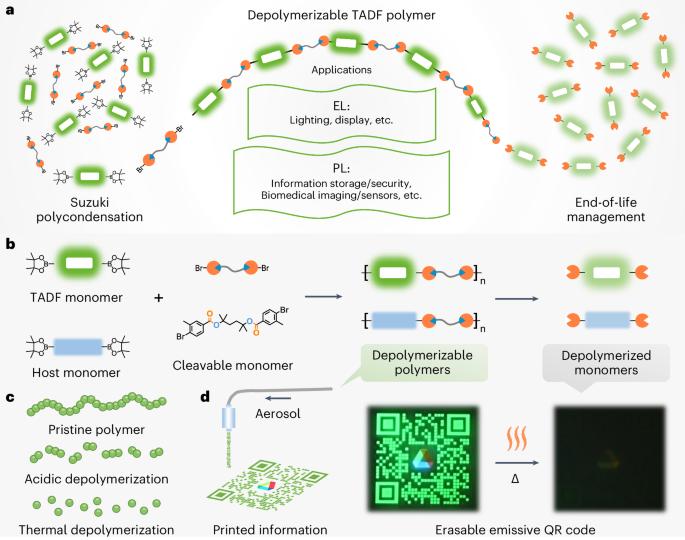可分解、可回收的高发光效率发光聚合物
IF 25.7
1区 环境科学与生态学
Q1 ENVIRONMENTAL SCIENCES
引用次数: 0
摘要
发光聚合物在电致发光、生物成像、医疗诊断、生物刺激和安全标识等多项光子技术中具有重要意义。在发光聚合物中加入可解聚性和可回收性对于促进其可持续发展以及在产品生命周期结束时最大限度地减少对环境的影响至关重要,但现有的策略往往会影响发光效率。在此,我们开发了一种策略,利用可裂解的分子来制造可解聚和可回收的热激活延迟荧光(TADF)聚合物,而不会影响其高发光效率。基于 TADF 聚合物的电致发光器件的外部量子效率高达 15.1%。TADF 聚合物可在弱酸性或加热条件下解聚,动力学过程可精确控制,获得的纯单体可分离并重新聚合,用于后续生活应用。这项工作促进了发光材料在报废时的环保性和循环性,为可持续发展的光子产业铺平了道路。开发具有高发光效率的可解聚和可回收聚合物对可持续光子技术至关重要,但仍然具有挑战性。在此,作者设计了一种基于可控裂解分子的聚合物开发策略。本文章由计算机程序翻译,如有差异,请以英文原文为准。

Depolymerizable and recyclable luminescent polymers with high light-emitting efficiencies
Luminescent polymers are of great interest in a number of photonic technologies, including electroluminescence, bioimaging, medical diagnosis, bio-stimulation and security signage. Incorporating depolymerizability and recyclability into luminescent polymers is pivotal for promoting their sustainability and minimizing their environmental impacts at the end of the product lifecycle, but existing strategies often compromise the light-emitting efficiencies. Here we develop a strategy that utilizes cleavable moiety to create depolymerizable and recyclable thermally activated delayed fluorescence (TADF) polymers without compromising their high light-emitting efficiencies. The electroluminescent devices based on the TADF polymers achieved a high external quantum efficiency of up to 15.1 %. The TADF polymers can be depolymerized under either mild acidic or heating conditions, with precise control of the kinetics, and the obtained pure monomers can potentially be isolated and repolymerized for subsequent life applications. This work promotes the end-of-life environmental friendliness and circularity of luminescent materials, paving the way to a sustainable photonic industry. Developing depolymerizable and recyclable polymers with high light-emitting efficiencies is of vital importance for sustainable photonic technologies, but remains challenging. Here the authors design a strategy to develop such polymers based on the use of controllable cleavable moiety.
求助全文
通过发布文献求助,成功后即可免费获取论文全文。
去求助
来源期刊

Nature Sustainability
Energy-Renewable Energy, Sustainability and the Environment
CiteScore
41.90
自引率
1.10%
发文量
159
期刊介绍:
Nature Sustainability aims to facilitate cross-disciplinary dialogues and bring together research fields that contribute to understanding how we organize our lives in a finite world and the impacts of our actions.
Nature Sustainability will not only publish fundamental research but also significant investigations into policies and solutions for ensuring human well-being now and in the future.Its ultimate goal is to address the greatest challenges of our time.
 求助内容:
求助内容: 应助结果提醒方式:
应助结果提醒方式:


